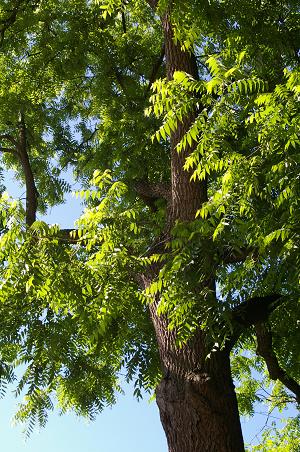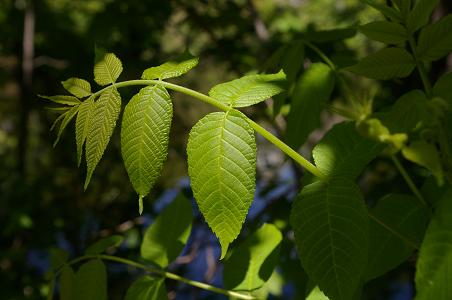GLEBE TREES AND SHRUBS
Black walnut (Juglans nigra)
Form
 This photo was taken on Pope's Lane, at the T-junction, June 21, 2008.
Grows to be a tall tree.
This photo was taken on Pope's Lane, at the T-junction, June 21, 2008.
Grows to be a tall tree.
Leaves
 Brown's Inlet, Broadway Ave, May 25, 2008.
Black walnut leaves are similar to butternut but the terminal leaflet is small, the middle leaflets
are the largest, getting smaller to either end.
Brown's Inlet, Broadway Ave, May 25, 2008.
Black walnut leaves are similar to butternut but the terminal leaflet is small, the middle leaflets
are the largest, getting smaller to either end.
Bark
 This photo was taken on Pope's Lane, at the T-junction, May 8, 2008.
This photo was taken on Pope's Lane, at the T-junction, May 8, 2008.
Similar species
Only butternut can be confused with it when grown tall.
Butternut is very similar to black walnut, the latter being more common in the Glebe.
Butternut is hairier, stickier, lighter green, generally less elegant leaf features.
The butternut leaflets tend to get smaller moving toward the base. There is usually a prominent
terminal leaflet, whereas it is usually absent on black walnut leaves. The butternut leaf axis
is quite hairy whereas the walnut axis is pretty smooth. The butternut leaflets crows the axis,
even overlapping it. Not on the walnut leaves. Walnut leaflets seem to me to be quite asymmetrical
at the base, especially toward the tip. Less so on butternut.
The black walnut fruit are spherical but some look almost pear-shaped to me. This may be a
maturation question. Butternut bark has ridges which are apparently more flat-topped than black walnut.
Hickory has far fewer leaflets, resembling ash.
Mountain ash and sumac also have compound leaves. These are usually a lot less tall, more like
tall shrubs.. Sumac trunks are slender and can be fuzzy. Honey locust can be toothed or not, and has much
smaller leaflets than black walnut. False spirea is a type of mountain ash, with leaves that look like sumac to me.
Ash, red elderberry and elder have opposite, compound leaves.
List of trees and shrubs with alternate, compound, toothed leaves
 This photo was taken on Pope's Lane, at the T-junction, June 21, 2008.
Grows to be a tall tree.
This photo was taken on Pope's Lane, at the T-junction, June 21, 2008.
Grows to be a tall tree.
 Brown's Inlet, Broadway Ave, May 25, 2008.
Black walnut leaves are similar to butternut but the terminal leaflet is small, the middle leaflets
are the largest, getting smaller to either end.
Brown's Inlet, Broadway Ave, May 25, 2008.
Black walnut leaves are similar to butternut but the terminal leaflet is small, the middle leaflets
are the largest, getting smaller to either end.
 This photo was taken on Pope's Lane, at the T-junction, May 8, 2008.
This photo was taken on Pope's Lane, at the T-junction, May 8, 2008.